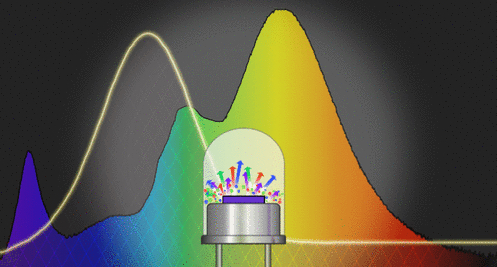Building a healthier LED bulb

University of Houston researchers' new prototype LED lightbulb emits less troublesome blue light
LED lightbulbs offer considerable advantages over other types of lighting. Being more efficient, they require much less electricity to operate. They do not give off unwanted heat the way old-school incandescent bulbs do, and the best of them long outlast even fluorescent lightbulbs.
But LEDs are not problem-free. Questions linger over suspected links between health concerns such as fatigue, mood disorders, and insomnia from overexposure to the blue-tinted light produced by today's standard LED bulbs. Plus, higher prices can prompt lightbulb shoppers to weigh other options.
A University of Houston research team led by Jakoah Brgoch, associate professor of chemistry in the College of Natural Sciences and Mathematics and principal investigator in the Texas Center for Superconductivity, is developing an LED bulb that emits most of its energy from the safer violet segment of the visible light spectrum. Instead of just masking the blue light, they are developing a unique class of phosphors that absorb a violet LED's single-colour emission and convert the light to cover the majority of the visible spectrum.
"Our group is creating phosphors that operate, not with the conventional blue LED chip that nearly every LED light bulb uses today, but with a violet LED chip. This basically moves away from blue to violet as the base source and then converts the violet LED light into the broad-spectrum white light that we see," Brgoch explained. "Our ultimate goal is for this new violet-based bulb to be as energy efficient as possible and also cheap, eventually making new lighting technology marketable to consumers."
Results of their research were recently published in ACS Applied Materials and Interfaces, a journal of the American Chemical Society.
Their work reports a new phosphor that meets this demand. Na2MgPO4F:Eu2++ can be excited by a violet LED yielding an efficient, bright blue emission. The material also shows zero thermal quenching and has outstanding chromatic stability. The chemical robustness of the phosphor was also confirmed through prolonged exposure to water and high temperatures. A prototype device using a 405 nm LED, Na2MgPO4F:Eu2+, and a green and red-emitting phosphor produces a warm white light with a higher colour rendering index than a commercially purchased LED light bulb while significantly reducing the blue component.
"With the advent of LED lighting, companies have started trying to understand how humans interact with light and, more importantly, how light interacts with humans," Brgoch said. "As you sit in your office, the blue hues in your light are a great thing because they help you stay alert. But that same light at night might keep you awake. This is the balance you have to strike. It's about following a natural circadian cycle without disruption."
Sleep studies reveal that nighttime overexposure to blue frequencies can alter hormones like melatonin, sometimes leading to insomnia, disturbed sleep cycles, and other problems. Too much blue-light exposure also is suspected in cataract formation. Interestingly, urban dwellers living amid LED-based street lights, traffic lights, and lighted commercial signs are exposed to more day-and-night LED exposure than suburbanites.
"That's not to say we should just remove all the blue light from your lightbulbs. You need some of the blue spectrum. It's not about eliminating the blue, it's about keeping it to a reasonable level. That's what we're seeking with our work," said graduate research assistant Shruti Hariyani, co-author of the paper.
'Advancing Human-Centric LED Lighting Using Na2MgPO4F:Eu2+' by Dhruti Hariyani and Jakoah Brgoch; ACS Applied Materials and Interfaces, March 2021


































